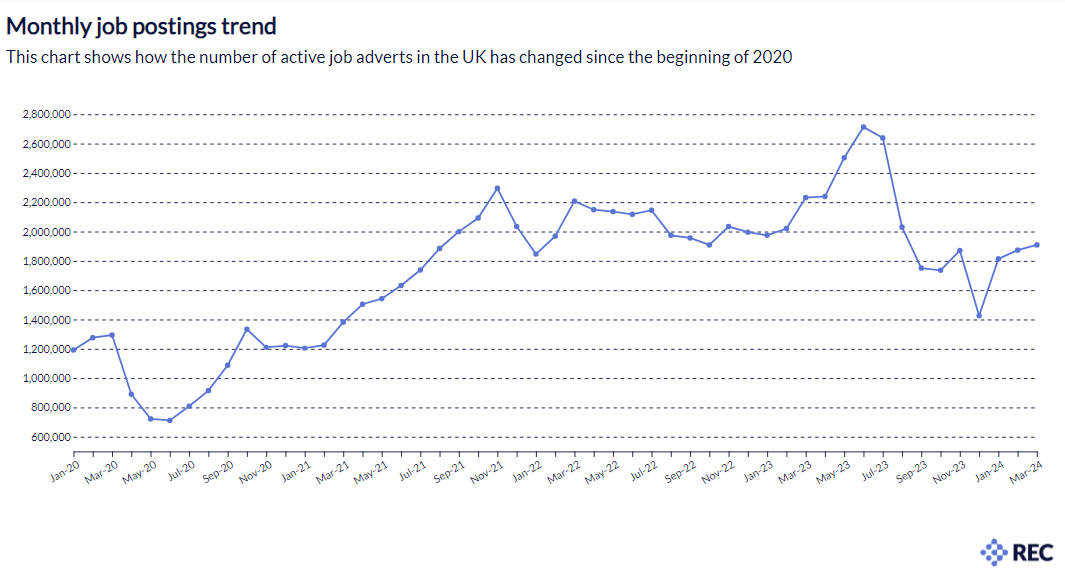Job ads underscore hopes for labour market resilience

- The number of active postings in March 2024 was 1,908,641 – up on the number in February 2024 – and suggesting a gentle rise in hiring activity since the winter. As a leading indicator for the labour market, this underscores more hopeful economic predictions for the summer.
- There were 848,004 new job postings in March 2024 – a 4.2% rise from the month before.
- Across the UK (United Kingdom), Na h-Eileanan Siar (25.5%), Causeway Coast and Glens (24.6%) and West Dunbartonshire (14.7%) had among the highest growth in job postings when compared to last month.
- Demand for workers in Scotland has rebounded.
- Posting levels overall remain below the levels of last year.
Despite falling activity across the winter, the job market is reacting to more positive signals on growth this spring, according to the latest Recruitment & Employment Confederation (REC) and Lightcast Labour Market Tracker.
There were more than 1.9m active job postings in the UK, with 848,004 new job postings in March 2024. While active job postings show a marginal growth of 1.1% compared to February, it is a further sign of steady growth in demand for labour, especially as the change was led by new postings, rather than older postings staying online.

REC Chief Executive Neil Carberry said:
“Over the past few weeks, we are starting to see some signs of firms gearing up for growth. The first indication of this in the labour market is this rise in job adverts. It will take time for this to feed through to higher placement levels, especially as recruiters report longer decision-making processes from hiring businesses right now. And we shouldn’t get carried away, as activity is still well below last year’s levels at this point, but further declines in labour market activity now seem less likely, especially as inflation and pay awards are normalising.”
Neil Carberry added:
“Businesses are looking for political parties to put growth at the heart of their programmes, and that means backing business. Manifestoes for the General Election need to focus on the long-term and address business concerns on skills, infrastructure and regulation if we are to make the most of the UK’s potential – and that starts with our workforce. We could unlock £39bn of growth annually if government and business work together to get the people stuff right.”
Occupations with notable increases in adverts in March 2024 include Collector Salespersons and Credit Agents (40.0%) (who visit private households to obtain orders and collect payments for goods and services), Air Transport Operatives (26.2%) and Mining and Quarry Workers and Related Operatives (22.7%).
There was also growing demand for Tool Makers, Tool Fitters and Markers-out (22.0%), Road Transport Drivers n.e.c. (21.3%) and Mobile Machine Drivers and Operatives n.e.c. (19.3%).
Childminders (-25.4%), Quality Control and Planning Engineers (-35.3%) and Prison Service Officers (Below Principal Officer) (-37.3%) all showed the largest decline in roles from February 2024 to March 2024. This is the second consecutive month where job postings for Prison Service Officers have been in the bottom ten occupations.
Across the UK, Na h-Eileanan Siar (25.5%), Causeway Coast and Glens (24.6%) and West Dunbartonshire (14.7%) had among the highest growth in job postings when compared to February 2024.
Luton (-8.3%), Wakefield (-9.5%) and Barnsley, Doncaster and Rotherham (-10.2%) all accounted for the sharpest decline in job postings.
Scottish and Northern Irish counties dominate the top ten regions with the highest percentage of growth. Most of the top ten counties were based in Scotland and the remaining four were based in Northern Ireland. After a few months of sluggish growth, overall Scotland posted the highest growth of all government regions (7.0%).











Responses